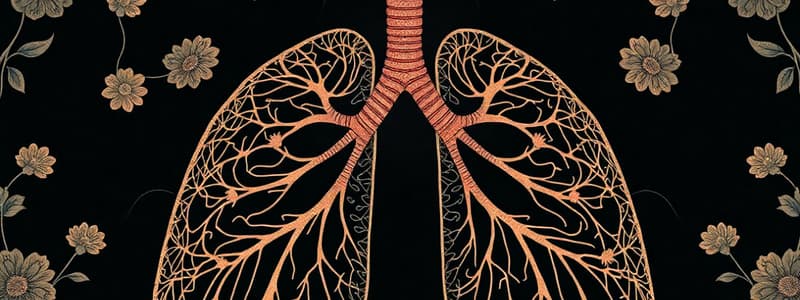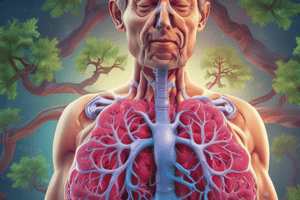Podcast
Questions and Answers
What is the primary function of the mucous membrane lining the trachea?
What is the primary function of the mucous membrane lining the trachea?
- To facilitate the exchange of gases
- To produce air pressure
- To aid in digestion
- To trap foreign particles (correct)
What structural feature of the bronchi is specifically mentioned as helping during swallowing?
What structural feature of the bronchi is specifically mentioned as helping during swallowing?
- C-shaped cartilages (correct)
- Smooth muscle fibers
- Circular rings
- Goblet cells
What is the role of alveoli in the respiratory system?
What is the role of alveoli in the respiratory system?
- To carry oxygen to the heart
- To facilitate the exchange of gases (correct)
- To produce mucus
- To filter incoming air
What happens to smokers' air passages due to tar accumulation?
What happens to smokers' air passages due to tar accumulation?
Which part of the respiratory system is directly involved in moving air during breathing?
Which part of the respiratory system is directly involved in moving air during breathing?
What happens to blood as it passes through the alveoli?
What happens to blood as it passes through the alveoli?
What is the role of intercostal muscles in the respiratory process?
What is the role of intercostal muscles in the respiratory process?
Which of the following correctly describes the pleura surrounding the lungs?
Which of the following correctly describes the pleura surrounding the lungs?
What is the main function of the larynx in the respiratory system?
What is the main function of the larynx in the respiratory system?
Which statement best describes internal respiration?
Which statement best describes internal respiration?
Which structure is part of the upper respiratory tract?
Which structure is part of the upper respiratory tract?
Which gas is typically considered to have the highest concentration in the atmosphere?
Which gas is typically considered to have the highest concentration in the atmosphere?
What is the primary role of the diaphragm in the respiratory system?
What is the primary role of the diaphragm in the respiratory system?
Which part of the respiratory system is primarily responsible for warming and filtering the air?
Which part of the respiratory system is primarily responsible for warming and filtering the air?
What happens to particles that enter the larynx?
What happens to particles that enter the larynx?
What is the primary function of external respiration?
What is the primary function of external respiration?
What happens to the diaphragm during inspiration?
What happens to the diaphragm during inspiration?
Which factor does NOT affect the diffusing capacity (DLCO) of gases across the alveolar-capillary membrane?
Which factor does NOT affect the diffusing capacity (DLCO) of gases across the alveolar-capillary membrane?
What percentage of oxygen is transported by hemoglobin in the blood?
What percentage of oxygen is transported by hemoglobin in the blood?
How is breathing rate primarily regulated?
How is breathing rate primarily regulated?
What is Tidal Volume?
What is Tidal Volume?
Which of the following pressures represents partial pressure of oxygen at sea level?
Which of the following pressures represents partial pressure of oxygen at sea level?
What occurs during expiration in terms of rib position and thoracic cavity volume?
What occurs during expiration in terms of rib position and thoracic cavity volume?
What is one of the control mechanisms for breathing besides neural control?
What is one of the control mechanisms for breathing besides neural control?
Flashcards
External Respiration
External Respiration
The process of gas exchange between the air sacs of the lungs and the bloodstream.
Internal Respiration
Internal Respiration
The process of gas exchange between the bloodstream and the cells of the body.
Cellular Respiration
Cellular Respiration
The breakdown of glucose within cells to release energy, using oxygen and producing carbon dioxide as a byproduct.
What are the organs of the Upper Respiratory Tract (URT)?
What are the organs of the Upper Respiratory Tract (URT)?
Signup and view all the flashcards
What are the organs of the Lower Respiratory Tract (LRT)?
What are the organs of the Lower Respiratory Tract (LRT)?
Signup and view all the flashcards
What is the role of the epiglottis?
What is the role of the epiglottis?
Signup and view all the flashcards
What is the purpose of the vocal cords?
What is the purpose of the vocal cords?
Signup and view all the flashcards
What is the function of the trachea?
What is the function of the trachea?
Signup and view all the flashcards
What is ventilation?
What is ventilation?
Signup and view all the flashcards
Describe inspiration.
Describe inspiration.
Signup and view all the flashcards
Describe expiration.
Describe expiration.
Signup and view all the flashcards
What is Tidal Volume?
What is Tidal Volume?
Signup and view all the flashcards
What is partial pressure?
What is partial pressure?
Signup and view all the flashcards
Explain gas diffusion in the lungs.
Explain gas diffusion in the lungs.
Signup and view all the flashcards
What factors affect the diffusing capacity (DLCO) of the lungs?
What factors affect the diffusing capacity (DLCO) of the lungs?
Signup and view all the flashcards
How is oxygen transported in the body?
How is oxygen transported in the body?
Signup and view all the flashcards
What is the function of the C-shaped cartilage in the trachea?
What is the function of the C-shaped cartilage in the trachea?
Signup and view all the flashcards
Explain the function of cilia and goblet cells in the trachea.
Explain the function of cilia and goblet cells in the trachea.
Signup and view all the flashcards
What are bronchi and bronchioles?
What are bronchi and bronchioles?
Signup and view all the flashcards
Describe the location and function of the lungs.
Describe the location and function of the lungs.
Signup and view all the flashcards
What are the pleura and pleural fluid, and what is their role?
What are the pleura and pleural fluid, and what is their role?
Signup and view all the flashcards
Explain the function of alveoli in gas exchange.
Explain the function of alveoli in gas exchange.
Signup and view all the flashcards
Describe the role of the diaphragm and intercostal muscles in breathing.
Describe the role of the diaphragm and intercostal muscles in breathing.
Signup and view all the flashcards
What happens to oxygen levels at high altitudes, and how does the body adapt?
What happens to oxygen levels at high altitudes, and how does the body adapt?
Signup and view all the flashcards
Study Notes
Respiratory System Overview
- The respiratory system is a network of tubes that filters, transports, and exchanges gases.
- The system aims to bring oxygen into the body and remove carbon dioxide.
- The respiratory system is split into the upper respiratory tract (URT) and the lower respiratory tract (LRT).
Respiratory System Objectives
- Define external, internal, and cellular respiration.
- Name the organs of the respiratory system and describe their functions.
- Explain the role of respiratory muscles in inspiration and expiration.
Respiratory Definitions
- External respiration: Gas exchange between blood capillaries and air sacs in the lungs.
- Internal respiration: Gas exchange between blood capillaries and body cells.
- Cellular respiration: The breakdown of organic molecules (usually glucose) in cells to produce energy.
Atmospheric Gases
- Rank gases in the atmosphere by concentration: Nitrogen, Oxygen, Others, Carbon Dioxide
Respiratory System Structures
- Nose and Mouth: Supported by bone and cartilage, lined with mucous membranes containing hairs. Hairs filter and the mucosa warms and moistens the incoming air. Air and food are separated by the hard and soft palates. The pharynx is a common passageway for both air and food.
- Air Passages: Include the larynx, trachea, bronchi, and bronchioles. The larynx contains vocal cords. The trachea is supported by cartilages. Bronchi branch into smaller bronchioles.
- Lungs: Spongy cone-shaped organs that occupy most of the thoracic cavity. The lungs are separated by the mediastinum. Visceral and parietal pleura surround the lungs and create a fluid-filled space between them.
- Diaphragm, Ribs & Intercostal Muscles: The diaphragm is a large sheet of muscle, ribs protect the internal organs, and intercostal muscles move the ribs during breathing.
Lung Structure
- The bronchi divide into progressively smaller bronchioles which lead to alveolar ducts.
- Alveolar ducts open up into tiny air sacs called alveoli.
- Alveoli have thin walls with a rich supply of blood capillaries.
- Gases are exchanged across the thin alveolar walls.
Gas Transport and Diffusion
- Gas exchange rates are determined according to the partial pressure differences of each gas across the alveolar-capillary membrane.
- Oxygen and carbon dioxide move according to the concentration gradient, from high to low. This is diffusion.
- Oxygen is primarily carried by hemoglobin.
Breathing Mechanics
- Inspiration: The process of breathing in. The diaphragm contracts and moves downward, the intercostal muscles contract, the thoracic cavity expands, and the air pressure in the alveoli decreases, so air flows in.
- Expiration: The process of breathing out. The diaphragm relaxes, moves upward, the intercostal muscles relax, the thoracic cavity shrinks, and the air pressure in the alveoli increases, so air flows out.
Respiratory System Control
- Neural control: The breathing rhythm is controlled by respiratory centers in the brainstem (medulla and pons).
- Chemical control: Chemical receptors in the bloodstream sense changes in blood carbon dioxide (CO2) levels or pH, which influence the breathing rate.
- Intrapulmonary receptors: Receptors in the lungs respond to factors such as lung inflation and send signals to regulate breathing.
Summary of Factors Affecting Breathing Rate
- Breathing rate changes with age.
- Breathing rate increases during and after exercise.
- Control of breathing is mostly automatic (involuntary).
Important aspects of the Respiratory System
- The respiratory system is essential for gas exchange which is the primary function.
- A range of different structures and mechanisms work together to ensure efficient gas exchange.
- Airflow within the system is regulated via various nerves and muscles as well as other signals.
- The respiratory system is affected by smoking as tar in cigarettes coats the air passages.
Studying That Suits You
Use AI to generate personalized quizzes and flashcards to suit your learning preferences.




